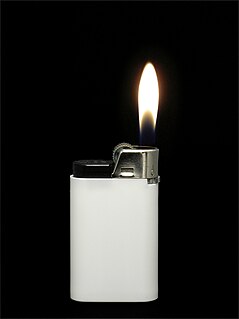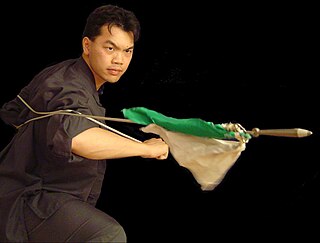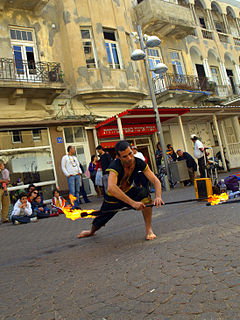Kerosene, paraffin, or lamp oil is a combustible hydrocarbon liquid which is derived from petroleum. It is widely used as a fuel in aviation as well as households. Its name derives from Greek: κηρός (keros) meaning "wax", and was registered as a trademark by Canadian geologist and inventor Abraham Gesner in 1854 before evolving into a generic trademark. It is sometimes spelled kerosine in scientific and industrial usage. The term kerosene is common in much of Argentina, Australia, Canada, India, New Zealand, Nigeria, and the United States, while the term paraffin is used in Chile, eastern Africa, South Africa, Norway, and in the United Kingdom. The term lamp oil, or the equivalent in the local languages, is common in the majority of Asia and the Southeastern United States. Liquid paraffin is a more viscous and highly refined product which is used as a laxative. Paraffin wax is a waxy solid extracted from petroleum.

A torch is a stick with combustible material at one end, which is ignited and used as a light source. Torches have been used throughout history, and are still used in processions, symbolic and religious events, and in juggling entertainment. In some countries "torch" in modern usage is the term for a battery-operated portable light.

A candle is an ignitable wick embedded in wax, or another flammable solid substance such as tallow, that provides light, and in some cases, a fragrance. A candle can also provide heat or a method of keeping time.
The Olympic flame is a symbol used in the Olympic movement. It is also a symbol of continuity between ancient and modern games. Several months before the Olympic Games, the Olympic flame is lit at Olympia, Greece. This ceremony starts the Olympic torch relay, which formally ends with the lighting of the Olympic cauldron during the opening ceremony of the Olympic Games. The flame then continues to burn in the cauldron for the duration of the Games, until it is extinguished during the Olympic closing ceremony.

A kerosene lamp is a type of lighting device that uses kerosene as a fuel. Kerosene lamps have a wick or mantle as light source, protected by a glass chimney or globe; lamps may be used on a table, or hand-held lanterns may be used for portable lighting. Like oil lamps, they are useful for lighting without electricity, such as in regions without rural electrification, in electrified areas during power outages, at campsites, and on boats. There are three types of kerosene lamp: flat-wick, central-draught, and mantle lamp. Kerosene lanterns meant for portable use have a flat wick and are made in dead-flame, hot-blast, and cold-blast variants.

A lantern is an often portable source of lighting, typically featuring a protective enclosure for the light source – historically usually a candle or a wick in oil, and often a battery-powered light in modern times – to make it easier to carry and hang up, and make it more reliable outdoors or in drafty interiors. Lanterns may also be used for signaling, as torches, or as general light-sources outdoors.

A hula hoop is a toy hoop that is twirled around the waist, limbs or neck. They have been used by children and adults since at least 500 BC. The modern hula hoop was inspired by Australian bamboo hoops. The new plastic version was popularized in 1958 by the Wham-O toy company and became a fad. Hula hoops for children generally measure approximately 70 centimetres (28 in) in diameter, while those for adults measure around 100 centimetres (39 in). Traditional materials for hoops include willow, rattan, grapevines and stiff grasses. Today, they are usually made of plastic tubing.

A lighter is a portable device which generates a flame, and can be used to ignite a variety of items, such as cigarettes, gas stoves, fireworks, candles or campfires. It consists of a metal or plastic container filled with a flammable liquid or compressed gas, a means of ignition to produce the flame, and some provision for extinguishing the flame. Alternatively, a lighter can be powered by electricity, using an electric arc or heating element to ignite the target.

Fire eating is the act of putting a flaming object into the mouth and extinguishing it. A fire eater can be an entertainer, a street performer, part of a sideshow or a circus act but has also been part of spiritual tradition in India.

Fire performance is a group of performance arts or skills that involve the manipulation of fire. Fire performance typically involves equipment or other objects made with one or more wicks which are designed to sustain a large enough flame to create a visual effect.

A beverage-can stove, or pop-can stove, is a do it yourself, ultralight, alcohol-burning portable stove. The simple design is made entirely from aluminium cans, lending itself to countless variations.

The rope dart or rope javelin, also known as Jōhyō in Japanese, is one of the flexible weapons in Chinese martial arts. Other weapons in this family include the meteor hammer, flying claws, Fei Tou flying weight, and chain whip. Although the flexible weapons share similar movements, each weapon has its own specific techniques.

Poi is a performing art and also the name of the equipment used for its performance. As a skill toy, poi is an object or theatrical prop used for dexterity play or an object manipulation. As a performance art, poi involves swinging tethered weights through a variety of rhythmical and geometric patterns. Poi artists may also sing or dance while swinging their poi. Poi can be made from various materials with different handles, weights, and effects.

Juggling torches are one of various props used by jugglers. Torches are usually commercially made props that are made of wood and/or metal with a wick attached at one end. The wick is soaked in liquid fuel, usually paraffin and ignited before use.
Some poi tricks include: reels, weaves, fountains, crossovers and windmills.
Hooping is the manipulation of and artistic movement or dancing with a hoop. Hoops can be made of metal, wood, or plastic. Hooping combines technical moves and tricks with freestyle or technical dancing. Hooping can be practiced to or performed with music. In contrast to the classic toy hula hoop, modern hoopers use heavier and larger diameter hoops, and frequently rotate the hoop around parts of the body other than the waist, including the hips, chest, neck, shoulders, thighs, knees, arms, hands, thumbs, feet, and toes. The hoop can also be manipulated and rotated off the body as well. Modern hooping has been influenced by art forms such as rhythmic gymnastics, hip-hop, freestyle dance, fire performance, twirling, poi, and other dance and movement forms.
Object manipulation is a form of dexterity play or performance in which one or more people physically interact with one or more objects. Many object manipulation skills are recognised circus skills. Other object manipulation skills are linked to sport, magic, and everyday objects or practices. Many object manipulation skills use special props made for that purpose: examples include the varied circus props such as balls, clubs, hoops, rings, poi, staff, and devil sticks; magic props such as cards and coins; sports equipment such as nunchaku and footballs. Many other objects can also be used for manipulation skills. Object manipulation with ordinary items may be considered to be object manipulation when the object is used in an unusually stylised or skilful way or for a physical interaction outside of its socially acknowledged context or differently from its original purpose.

A fire staff is a staff constructed out of wood or metal with Kevlar wick added to one or both ends. Fire staffs are used for fire performance.
Poi tricks are defined by the manipulation and combination of several variables of the spinning activity. These variables typically include, but are not limited to, the following:














